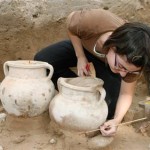 A team of Lebanese and Spanish archaeologists have uncovered a large cache of earthenware jars dating to the Phoenician era.
A team of Lebanese and Spanish archaeologists have uncovered a large cache of earthenware jars dating to the Phoenician era.
They weren’t for commercial use, though. No Tyrean purple destined for royal garments in those jars.
“The big jars are like individual tombs. The smaller jars are left empty, but symbolically represent that a soul is stored in them,” Ali Badawi, the archaeologist in charge in Tire, told Reuters Wednesday. […]
“These discoveries help researchers who work on past Phoenician colonies in Spain, Italy and Tunisia, to pin down a large number of their habits and traditions,” said Maria Eugenia Aubet, who leads the Spanish team.
War has taken a harsh toll on Lebanon’s efforts to uncover its rich history. This site has only recently seen work start up again. The last excavation before this was in 2005, before the war between Israel and Hezbollah made southern Lebanon too hot to handle.
Wait, so what was in the large jars that made them like individual tombs?
Wow, a soul in a jar–what an image!
Tyrean purple, is it? I always wondered how to translate the Hebrew argaman. Thanks! Now I Googled and also was delighted to learn this:
In Phoenician times, Sour (Tyre) was famous for its export of richly dyed purple textiles, using a dye extracted from the murex sea snail. Because of its rarity, the color was typically worn by royalty. The Tyrean purple dye was so highly valued that the Greeks named the people living in the city state “Phoenicians,” after the Greek word for “purple.”
So lots of rich discoveries for me in your post. Thanks teacher.
The article says “Lebanese and Spanish archaeologists have discovered 2,900-year-old earthenware pottery that ancient Phoenicians used to store the bones of their dead after burning the corpses,” which would make them little ceramic tombs. But it doesn’t actually say if there were any bodies in the jars, just that that is what they were used for. The headline suggests they did find bodies.
I think the author should have been a bit more specific here. Did the archaeologists uncover a Phoenician cemetery or a Phoenician ceramic tomb dealer?
A cemetery is cool, but how awesome would it be to find a tomb dealer? “And over here we have the Pot 2000, guaranteed to hold your longest long bone. Comes with standard soul bearing jug at no additional cost!”
😆 That would rule! The commerce aspect of funerary rituals is so often overlooked.
I agree the article isn’t as clear as it should be, but I think it unlikely that even a major urn seller would keep quite this much stock on hand.
Do teachers usually blush and giggle like schoolgirls when they get such a lovely compliment? Thank you kindly. :thanks:
About the Tyrean purple, did you know that the murex snail was known in Hebrew as the hilazon, and was the source of the deep blue dye used in the tzitzit?
The dye turns blue when exposed to sunlight; keep it in the dark until it sets and it’s Royal purple.
i got lots of infermaion!!!!
i have a question what is phoenicain pottery made from?
This set is earthenware, as I noted in the first sentence of this blog entry.
I love my teacher :love:
I would like to know the name of the instrument which used in making the pottery?
can y7ou help and give address of supplier?
Love it!.the ancient way of making pottery.I’m a passionate potter that is why I’m so amazed knowing about this Phoenician pottery.
@ elie madi:
It’s called a “potter’s wheel.” And a “and ancient potter’s wheel” or “an ancient potter” doesn’t have “an address.” Though there ARE modern potters to this day. But asking for “THE address” of a potter, is like asking for “THE address” of a franchise like McDonald’s. 😮